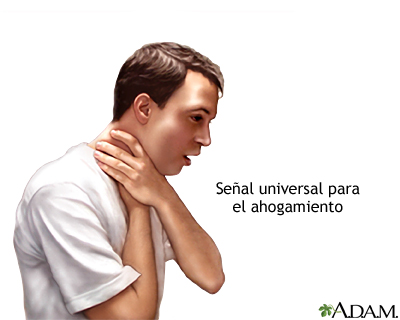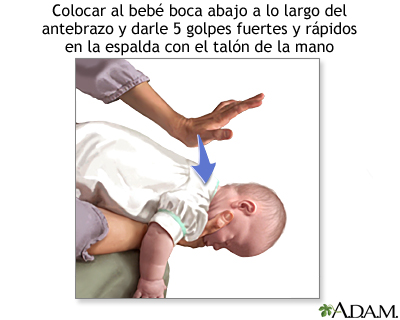
 A) Si alguien cerca de usted se ahogua.
A) Si alguien cerca de usted se ahogua. Si al momento de atragantarse la persona comienza a toser, es importante incentivarla a que siga haciéndolo ya que este es el mecanismo de defensa natural del cuerpo para expulsar el objeto.Si no se recupera y en cambio deja de toser dando señales de que le falta el aire, hay que comenzar con la maniobra de Heimlich.
Ante una persona conciente, en principio hay que tratar de mantenerla calma. Colocarse detrás de ella y con los brazos rodeando su cintura y ambas manos sobre su abdomen.
Las compresiones deben ser rápidas.
Si se trata de un niño, hay que aplicar el mismo método pero arrodillándose para quedar a su altura.
If choking when the person starts to cough, it is important to encourage it to continue to do so as this is the natural defense mechanism of the body to expel objeto.Si not recover and instead showing signs coughing stops short of the air, you have to start with the Heimlich maneuver.
Given a conscious person, in principle we should try to keep calm. Behind her and placed his arms around her waist and both hands on your abdomen.
Compressions should be fast.
If it's a child, apply the same method but kneeling to be at its height.

B) Esguince de tobillo.
- Siempre pensar que podría haber un esguince hasta que el especialista diga lo contrario.
- Aplicar hielo local INMEDIATAMENTE.
- Aplicar un vendaje simple sobre la zona, ni muy apretado ni muy suelto. Esto ayuda a contener la inflamación. Nunca dormir con el vendaje puesto y debemos sacarlo algunos momentos durante el día. El vendaje es INTERMITENTE. Se compran en cualquier farmacia.
- Inmovilizar la zona afectada con una muñequera, rodillera, tobillera según sea el caso. En los dedos podemos ponernos un “palito” de helado.
- Consultar a un Traumatólogo o Kinesiólogo para confirmar diagnóstico y planificar el tratamiento.
- Seguir con hielo local por los menos las primeras 48 hrs, y repetir la aplicación muchas veces al día por 15 minutos cada vez.
Apply ice packs IMMEDIATELY.
Apply a simple bandage over the area, neither too tight nor too loose. This helps contain inflammation. Never sleep with the bandage on and we get him some times during the day. The dressing is FLASHING. We buy in any pharmacy.
Immobilize the affected area with a cuff, knee, ankle area as appropriate. In the fingers we can put on a "stick" of ice cream.
Consult an orthopedic surgeon or kinesiologist to confirm diagnosis and plan treatment.
Continue with ice packs at least the first 48 hrs, and reapply several times a day for 15 minutes each time.
D) En caso de diarrea.


Para prevenir la deshidratación cuando usted tiene diarrea, es importante beber mucha agua, pero también debe tomar líquidos que contienen sodio, cloruro y potasio.
- Los adultos deben beber agua, jugo de frutas, bebidas deportivas, bebidas gaseosas sin cafeína y caldos salados.
- Los niños deben beber soluciones de rehidratación oral—bebidas especiales que contienen sales y minerales para prevenir la deshidratación
Si usted tiene diarrea, coma alimentos suaves y blandos tales como
- bananas
- arroz sencillo
- papas hervidas
- tostadas
- saltinas
- zanahorias cocidas
- pollo horneado sin piel ni grasa
To prevent dehydration when you have diarrhea, drink lots of water is important, but you should also drink fluids containing sodium, chloride and potassium.
Adults should drink water, fruit juice, sports drinks, soft drinks without caffeine and salty broths.
Children should drink solutions oral rehydration drink specials-containing salts and minerals to prevent dehydration
If you have diarrhea, eat soft, bland foods such as
bananas
plain rice
boiled potatoes
toast
saltine
cooked carrots
baked chicken without the skin or fat
C) Si te encuentras con un accidente de tráfico.
Qué hacer en un accidente
Verificar, primero su estado físico, y después el de sus acompañantes.
Llame a las autoridades, o al servicio de emergencia nacional.
Retírese a un lugar donde no haya tráfico.
Recopile e intercambie toda la información posible
No admita que tuvo la culpa para quitarse de problemas
Check first your fitness, and then that of his companions.
Call the authorities, or in the service of national emergency.
Retreat to a place where there is no traffic.
Collected and exchanged much information as possible
Do not admit you were at fault to get rid of problems
D) Si alguien cercano a usted tiene un ataque al corazón.
Hay tres acciones que, practicadas desde el primer instante, ofrecen a la persona cuyo corazón deja de latir la posibilidad de seguir viviendo. La persona testigo de un paro cardiaco debe llamar a una ambulancia, masajear el corazón de la víctima y utilizar un desfibrilador automático externo si hubiera uno cercano y disponible. Conocer la manera de proceder permite actuar con sangre fría y con mayor velocidad en caso de necesidad.
There are three actions, practiced for the first time, offer the person whose heart stops beating the chance to live. The person witnessed cardiac arrest should call an ambulance, massage the heart of the victim and use an automated external defibrillator if one is nearby and available. Knowing how to proceed can act coolly and with greater speed if necessary.
E) ¿Cómo hacer un torniquete?
Para hacer un torniquete efectivo, lo que tienes que hacer es ubicar el lugar de la herida, despues tienes que ubicar la articulacion mas cercana a la herida. Exactamente abajo de la articulacion tienes que poner alguna cinta o cuerda o algo que funcione para apretar en ese punto especifico, lo aprietas para detener el flujo de sangre, pero tienes que aflojarlo un poco cada minuto si la hemorragia es fuerte o cada 3 minutos si es una herida no tan profunda, para que la sangre siga circulando al resto del miembro.
tighten at that specific point,
you squeeze to stop the flow of blood, but you have to loosen it a bit every minute if the bleeding is severe, or every 3 minutes if is not as deep wound, to keep the blood circulating to the rest of the member.
James.. my dear..your posts are very well-fed... but the nature of the post is TO BE BRIEF AND STRIKING...keep those premises!!!!
ResponderEliminar